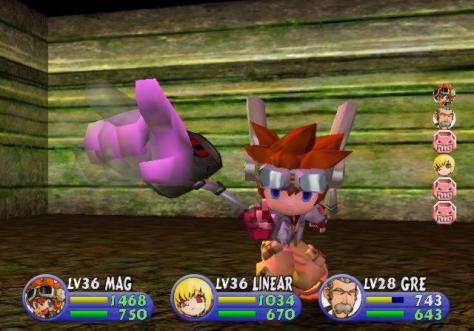
My memories of the experience are faint, but I can still recall renting Evolution Worlds from the local Blockbuster in the final months of junior high. Although I spent hours dungeon crawling, I never managed to complete the game. Even after purchasing a copy and replaying it a few years later, I failed to reach the finale. Since these playthroughs, I’ve viewed the game through a nostalgic lens, joyously recalling days gone by, and looking forward to that point in the indeterminate future when I set aside time to play it again. Well, last year was supposed to be the year I replayed it, as I was cherry-picking those games I always wanted to play or return to. I wound up not getting around to it then, but it was top of my list this year. After fifteen years, I’ve finally beaten Evolution Worlds!
Apart from nostalgia, I’ve wanted to replay this game to get a clearer picture of its composition as it’s quite unique. Evolution Worlds was not a “new” game when Ubisoft published it in North America on December 2, 2002. Instead, it was a compilation of sorts. An extremely abridged version of Evolution: The World of Sacred Device makes up the first few hours before the game transitions to Evolution 2: Far Off Promise. Both originally appeared on the Dreamcast (the former was actually the first RPG on the platform) but this package introduced a few improvements, such as fully voice-acted dialogue, a unified user interface, and minor graphical enhancements. Despite the amount of content cut from the first game, mostly chaff from what I call tell from skimming through the Prima strategy guide, this seems like the ideal way to play these games.
The dual storylines revolved around the teenage explorer Mag Launcher and his mysterious counterpart Linear Cannon. Heir apparent to a well-respected, and well-indebted, family of explorers, he continued their legacy by searching for clues and artifacts pertaining to their ancestors. In his world, the most successful explorers used Cyframes, technological marvels left behind by the supremely advanced, yet supremely extinct, prehistoric civilization. Advanced though they may have been the design of the Cyframes was comical, such as Mag’s default gear: a giant fist. Linear’s connection to these ancient peoples was revealed early on, which was unsurprising considering her unknown origins and peculiar, meek behavior.

A few other explorers and friends featured less prominently, but all worked in unison towards understanding the secrets of the prehistoric civilization, and Linear. These storylines, especially the actions and dialogue of the characters, reminded me of shōnen manga, or the anime that aired during the 4KidsTV block on Saturday mornings: cartoonish and intended for a teen, male-oriented audience. Were I not square in the target demographic when I first played this game, I may not have developed any fondness for it.
More than the narrative or characters, I’ve longed to replay this game to experience the dungeon crawling and turn-based combat. From a gameplay design standpoint, both are old-fashioned, and executed with little differentiating features, but done so with a respectable level of competence. It’s no wonder, as Sting Entertainment, the developer behind the series, had a few RPGs under their belt by the time these games debuted on the Dreamcast.

The first game was solely composed of randomly-generated dungeons, of which only a few were explored in this release. For the sequel however, a blend of random and designed dungeons were used; the former made up an optional training area while completion of the latter progressed the story. Regardless of type, exploring them was straight forward and unexciting (although it was enjoyable to see each floor’s layout fill in on the on-screen map). Exploring the dungeons was a test of endurance more than anything: could the party, and myself personally, muster the stamina to fight through scores of foes, avoid traps, ration healing items, and manage to defeat a tough boss? In most cases, the answer was yes. A smooth difficulty curve meant I hardly had to grind. Keyword: hardly, because as is the case with most JPRGs, I had to devote a not-insignificant amount of time to powering up my party before seeing the credits roll.
Like the dungeon design, combat and the related progression systems were uninspired, which isn’t intended as a derisive criticism. It merely seems to me the developers adopted standards for the genre, executed well, but did so without building upon them. Lacking a strengths/weaknesses aspect, turn-based battles were simple skirmishes where the most powerful survived. Boss fights were the rare occurrences when some sort of minimal strategy, such as designating a specific healer or defending before an attack, had to be implemented to succeed. Cyframes augmented the strength of a few party members, and unlocking special moves for these gave me something additional to work towards, besides a higher level or better gear. Oftentimes, the special attacks were amusing to watch, too.

So, after replaying Evolution Worlds, it’s a little clearer why my memories of the game were so faint: it’s somewhat unremarkable. I’m a sucker for any RPG that has rewarding character progression or otherwise enticing gameplay, and this game narrowly fits the bill; it’s a real meat and potatoes sort of RPG. Despite their basic designs, I did find it fulfilling to explore the various dungeons, systematically mapping out each floor. The increasing level of commitment wore on me however and after only twenty hours, I was ready to be done. Similarly the turn-based combat was impressively ordinary. I enjoyed battling, especially seeing the special moves I’d unlocked, but I eventually resorted to buttoning through fights while browsing Twitter. Despite these impressions, I’m honestly very happy to have finally completed it. And, in light of the amount of content that was cut from the first game, I wouldn’t mind giving the original Dreamcast release a whirl sometime…

One thought on “Evolution Worlds [GameCube] – Review”